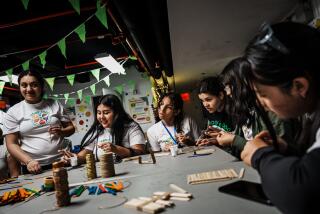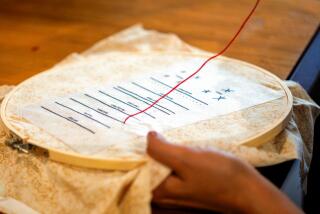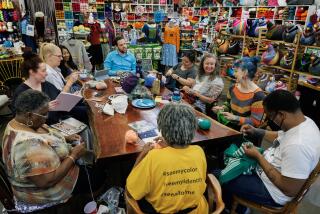Stitches in Time Honor Women, Immigrants
M eshuga , haimish and alter kocker are terms not likely to be heard at the vast majority of quilting bees, which are associated with pioneer women, the Amish and Appalachia.
But on Tuesday nights in Van Nuys, these Yiddish terms--meaning, respectively in loose translation: a crazy person, a good soul and a senior citizen--are part of the regular conversation of a group of Jewish quilters who are not about to be stopped by a cultural stereotype.
“About five years ago, we were down at the Craft and Folk Art Museum where they had an exhibit of quilts,” said Ruth Silver, 71, who had been taking cultural jaunts for years with a a group of San Fernando Valley friends.
“We were admiring these quilts that Amish women and other women from all over the United States had made,” Silver continued, “and I said, ‘Oh, hell, I’ll bet we could do that ourselves.’ ”
They could and they did, with the results being two quilts, one of which has gained renown far beyond their expectations. Their “Tribute to the American Woman” quilt--which pays homage to the contributions of 41 women in politics, science and the arts--was hung prominently in West Hollywood’s City Hall during that city’s monthlong Celebrating Women festival last March.
The group calls itself the Hamish Amish Quilters.
“When we started, no one expected it would become such a big thing in our lives,” said Ellie Sazer, 67, who now holds the meetings in her Van Nuys home. “It started out as something we did just for fun, just another reason for friends to get together. It turned out to be a lot more.”
In January, 1985, the group had its first formal meeting, at Silver’s house. The 14 women, who were mostly around retirement age, had known each other for a long time--some had friendships going back more than 30 years. “When we first moved to the Valley, that long ago,” Sazer said, “there was not a whole lot out here to do. We met through the local Jewish center and at the synagogue and became friends. We watched each other’s children grow up.”
The daughter of one of the women had some experience in quilting. She attended the first several meetings to get them started. “She taught us how to make the templates and the other special things we would need to make a quilt,” said Sylvia Edelstein, whose daughter, Lisa, was their teacher. “Some of us had done a lot of sewing in life and so we picked it up pretty fast.”
The group decided that its first quilt would be in the traditional Amish style, with a relatively simple geometric pattern and a limited range of colors. “It looked like the simplest one we could do to start,” Silver said. “Of course, when we got into it, it was not as simple as it had looked.”
It took a bit more than a year to complete the 88-by-96-inch quilt. In addition to the detailed work involved, time was taken up by socializing on quilting nights. “First, we had to talk about the grandchildren,” said Beverly Katz with a laugh. The slow pace was frustrating, at times, but rewarding.
“Sometimes when they were all working around a table,” said Bernard Kaplan, the husband of Ellie, “they would all start singing together. It was wonderful.”
The conversation around the table often included politics--several of the women had long been involved in liberal causes. And when the quilt was completed, they auctioned if for $1,700 at a Fourth of July party and donated most of the proceeds to an anti-nuclear weapons group.
Most of the women were anxious to start on a second quilt. Silver, a longtime activist, felt it should display more than an abstract pattern.
“As for me, if I was going to continue to be involved, I wanted it to be a very meaningful experience on more than a social level,” Silver said.
The group, now down to about 10 members, then decided to do a quilt that would honor U.S. women in several different fields: government, equal rights, the arts, sports and sciences. Everyone nominated women they thought should be considered, coming up with a total of 82.
But the quilt, as they planned it, would have room for a maximum of 42 squares.
“The process of elimination brought on a lot of discussion,” Silver said. Finally, after five weeks of talking, they decided to each choose the woman they most wanted on the quilt and make that square. That first group of choices included Eleanor Roosevelt, Leontyne Price, Isadora Duncan, Bella Lewitzky, Coretta Scott King, Georgia O’Keeffe, Lena Horne, Emma Lazarus and Mother Jones.
Most of the squares included a likeness of the subject, although some represented the person in other ways. The Isadora Duncan square, for example, featured a stitched drawing of two dancers in motion. Some of the women used a transfer process to imprint a likeness on the square to make their sewing easier. Others got help from Seymour Kaplan, a retired artist who is the husband of group member Millie Kaplan.
They continued to make individual choices until near the end, where there was a good deal of discussion about the last few that should go in. One square was dedicated to several women’s activist groups instead of a single person.
The most controversial choice was Ethel Rosenberg, convicted in the 1950s of spying for the Soviet Union and put to death. “To some of the women in the group, she represented the hysteria of the McCarthy years and what people had to go through at that time,” said Ann Becker, 69, who was a professional seamstress in New York in the 1940s. “There were those of us who thought she was put to death on flimsy charges.”
Becker machine-sewed the squares together before they were hand-stitched. She and others had second thoughts when the quilt was finished and garnering attention. “We thought that having her in there might keep people from showing the quilt,” she said of Rosenberg. “But no one has ever mentioned it.”
Making the quilt continued to be rewarding, socially, for the group, although the talk was not all of grandchildren and pleasant times. Toward the end of work on the second quilt, Silver’s marriage began to come apart. “I was able to share that, too, with the others to some degree,” Silver said. “It’s part of quilting. Sometimes you don’t just talk about the things that are easy to talk about.”
Soon after the quilt was finished, Silver moved to Walnut Creek, near San Francisco, where she is involved with groups that fight ageism.
As word of the finished quilt got around, local groups, including the Valley Cities Jewish Community Center in Van Nuys, invited them to show it and talk about it. “If it was looked at by an expert quilter, maybe they could see that our stitches are not always perfect,” Sazer said. “But it had a lot of meaning for us and we were proud of what we had done.”
Sazer’s nephew, who is involved in community activities in West Hollywood, suggested that the quilt be part of that city’s program for Women’s History Month last March. That city not only showed the quilt but put a picture of it on the cover of its brochure advertising events during its Celebrating Women festival. And it held a reception for the quilters.
“It was lovely,” Becker said. “The mayor at that time and her assistant were very instrumental in getting the quilt publicized. We got a lot of mileage out of that.”
After taking a break for several months, the Hamish Amish quilters have taken on their third project, a quilt on the theme of immigration and specifically Ellis Island. “Most of us have a parent who came to this country,” Edelstein said.
The group hopes the work on this quilt will move at a faster pace. “The grandchildren are older now,” Becker said. “They aren’t changing as quickly. We don’t have to talk about them as much.”
More to Read
The biggest entertainment stories
Get our big stories about Hollywood, film, television, music, arts, culture and more right in your inbox as soon as they publish.
You may occasionally receive promotional content from the Los Angeles Times.











